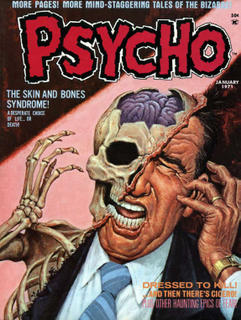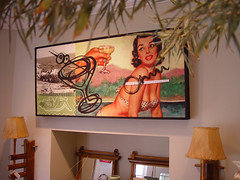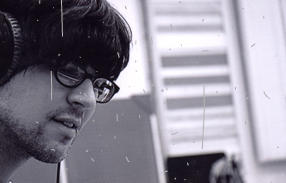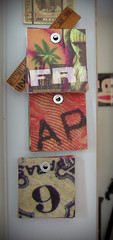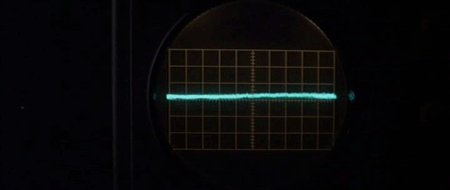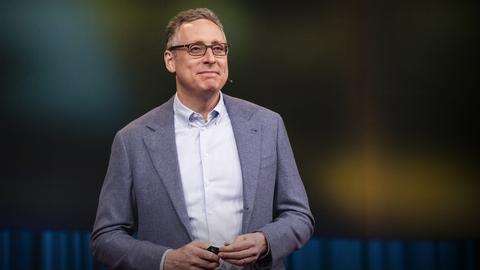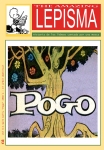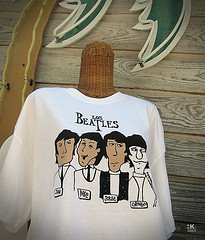
Halloween costume at a deaf social club, photo by Stephanie A. Hall
Where Our Weird Rituals Originated
Halloween, perhaps our weirdest annual celebration, is even stranger than it seems. Unlike the Fourth of July and Thanksgiving, it is neither patriotic nor historical, yet it is celebrated nationally. Unlike Christmas, Easter or Passover, Halloween is not associated with a particular religion. Yet it weaves spirituality, death and religious beliefs into our present and historical imaginations.
Halloween is hugely popular, infused with its own set of immediately recognizable symbols, rituals and stories. Yet most Americans have little, if any, sense of the hidden meanings and motives of the event in which they so enthusiastically participate.
Even its origin is complex and uncertain. Many Americans have heard rumblings that Halloween is a "pagan" or pre-European-Christian holiday with roots in Celtic traditions. A common and slightly elaborated version of this notion holds that Halloween is a descendent of the Celtic Samhain festival, which, on November 1, marked both the Celtic New Year and the day during which dead souls were believed to revisit Earth.
But the name "Halloween" has distinctly Christian origins. In efforts to stop seemingly non-Christian celebrations, the Roman Catholic Church incorporated Samhain festivities into the Christian calendar.
In 731 A.D., November 1 was declared All Saints' Day (All Hallows Day). October 31 thus became All Hallows Eve, in time shortened to "Halloween." Even with the encouragement of activities such as masquerading pageants of saints and the further, complicating step of adding Nov. 2 as All Souls Day to the church calendar after the year 1000, some "non-Christian" elements survive in Halloween.
Some elements, however, have a distinctively Native American heritage. One key symbol-the pumpkin-was unknown to Europeans before Columbus. But it was part of the sacred trinity of native American foods: squash, beans and maize, which appears in the form of candy corn and the corn shocks that decorate front porches. The original European version of the jack-o'-lantern was a turnip.
Some students of the holiday maintain that trick-or-treating is linked to Irish Samhain traditions and thus became popular about the time that the Irish began immigrating to the United States in large numbers. Presumably during Samhain, people opened their doors and provided food to the wandering dead, so people eventually started dressing like wandering dead souls and demanding food.
Others suspect that the custom was introduced to replace, or at least mitigate, the pranks or even destruction that typically accompanied the holiday even in the most conservative rural communities.
In Hoxie, a town of 1,500 in northwest Kansas, senior community members recall that, in the old days, "a certain number of outhouses became horizontal," when loose items such as garden hoses, trash cans and lawn furniture were dragged onto Main Street to block traffic the next morning.
However, trick-or-treating may be a relatively recent phenomenon coinciding with population shifts from rural to urban and suburban environments. It is, after all, difficult to go door to door when the doors are miles apart. Despite popular laments that Halloween is no longer the holiday "it always has been," folklorist Tad Tuleja argues that trick-or-treating may have developed during the 1930s as a means to control young people's Halloween night pranks.
The words "trick or treat" apparently were not in use until 1941, when they first appear in files of Merriam-Webster, Inc., after being used as the title of a poem in The Saturday Evening Post. According to the Oxford English Dictionary, the phrase "trick-or-treating" first appeared in The Sun in Baltimore in 1950. But the practice may be considerably older.
Finally, many students of folklore see in Halloween a connection to England's Guy Fawkes Day, the Nov. 5 commemoration of a foiled attempt to blow up the king and Parliament in the Gunpowder Plot of 1605. Guy Fawkes Day features bonfires, children soliciting "a penny for the guy" and pranking.
Halloween also may be related to early American harvest festivals, with apple bobbing, hayrides, and many local variations of games to divine the identity of a future mate. Those games probably derive from traditional beliefs in Britain and Ireland that spirits loosed on Halloween made the day particularly good for augury.
Connections to death, disorder, endings and to what Western traditions take to be the separate and set-apart world of the spirits all are consistent elements in tales about Halloween's origin.
Cultural anthropologists, who study the forms and meanings of human culture, have found that among the most intriguing meanings of Halloween are those listed below, each of them a window into the cultural and social dynamics of the country.
Dark Harvest
The quintessential symbols of Halloween fall into three major categories. Symbols of death include graveyards, ghosts, skeletons, haunted houses. Symbols of evil and misfortune are witches, goblins, black cats. Symbols of harvest are pumpkins, scarecrows, corn shocks and candy corn.
The first two categories tap deep, irresolvable, pan-human dilemmas. Ways of dealing with and symbolizing death and evil are represented in some of the earliest archaeological remains of human ritual activity. One traditional means of facing the reality of death is to view it as a transition and to continue a relationship with the dead
Hence the various rituals for keeping the departed involved in the present world through seances, graveside visits, prayer or other communication. Ideas about an afterlife or notions of ghosts and vampires also can be understood as attempts to challenge the finality and fear surrounding human mortality.
Ritual Reversals
Cultures have ways to challenge death but have a hard time beating it. Likewise, no culture has eliminated misfortune and evil, though humans keep trying. Typical American methods are control and avoidance-locking up, shutting out, buckling up, watching out, staying away.
Yet on Halloween, scary things suddenly are embraced wholeheartedly, brought to front porches and displayed. And children, those innocents whom we most want to protect from death and danger, are an integral part of the annual ritual.
At Halloween, Americans are doing something that all human beings do—confronting the unknown with special symbols and rituals.
For a while, we pull these fearful and painful realities into a relatively contained and public context. We share them with our children. We create a special and safe moment during which danger and death, skeletons and strangers can safely be part of our experience. Then we lock our doors again and return to our everyday, safe American lives. Halloween reverses the usual order of many things in many ways.
Anthropologists have analyzed rituals of reversal in settings around the world. Days when the living walk around as if dead, and the dead are thought to walk around as if living, are not that unusual. In fact, Halloween can be seen as the American inversion ritual par excellence.
During rituals of inversion, people can violate otherwise solid social codes. Less powerful people can break the rules, reverse the order of expected actions, flaunt otherwise unacceptable ways of dress or behavior or reverse the usual roles of parent-child, boss-worker, male-female.
Thus, it is common to see groups of children "threatening" adults for candy. Everyday people don masks of the famous. Adults dress like children and children like adults. Pranks and mockery ordinarily not allowed become commonplace.
In the past, many anthropologists focused on the conservative functions of rituals, considering the reversals a sort of social pressure-release valve. In this view, the Halloween ritual means something like:
"Let the children eat as much candy as they want, let the poor be rich, let the dead walk the Earth, let us get scared out of our wits and let us make fun of those we usually must respect. Afterward, we'll be better able to cope with, and settle for, our usual lives."
Celebrating youngsters create their own pumpkin patch. (The Post)
But that doesn't get at the power of ritual to make everyday life different.
More recently, anthropologists have shown that maintaining the status quo is not the only result of rituals of reversal. The rituals can actually reshape the usual order of things.
For instance, the gay community has actively used the holiday to assert a new and more visible social presence and power. The fantasy elements of masquerade, which temporarily permit one to be virtually whomever he or she wants to be, can foster true personal liberation and change. Playing a Halloween prank on a too-serious boss may change the tone of the office after the holiday.
The ritual reversals of Halloween also have potential power for children, serving as an opportunity to go to the door of the spooky house, visit a graveyard or visit the otherwise not-too-friendly neighbor.
Nevertheless, Halloween is still profoundly about sociability and norms. Reversals must fall within socially prescribed boundaries. Pranks and jokes are not supposed to cause permanent harm. Children are expected to say thank you at the door. Halloween can reinforce neighborliness and pro-social behavior.
Horror Stories
The symbols and rituals of Halloween link disorder and danger with cultural ideas about order and safety. But chaos still lurks, in reality or, much more often, in durable legends.
Virtually everyone has heard at least one story about poison or razor blades in apples, hypodermics in candy or dangerous items in grab bags. Each year, these stories are revived, and precautions are taken. Some call for an end to trick-or-treating, many parents allow children to visit only homes of people they know and many hospitals provide free candy X-ray service. Every year, new horror stories emerge, and old ones are retold.
Many social analysts have reasoned that these stories, while often thought true, are really examples of "urban legends" in the making, much the same as accounts of giant alligators in city sewers or rodents in soft-drink bottles. Horrible Halloween incidents occur occasionally. But how many people have firsthand evidence of someone hurt by Halloween candy? Seen in context, our fears about dangerous treats often seem more like ritual retellings than strictly rational worries.
Shopping malls and many schools now offer a "safe" alternative to neighborhood trick-or-treating so children will not be exposed to presumed danger. Local customs have changed accordingly. A resident of Severn, Md., says that "no one hands out any homemade items or home-filled treat bags, knowing that, when the children get home, their parents will" trash those items.
Strictly speaking, however, one should have no more reason to trust mall shopkeepers, whom the family does not know personally, than to mistrust people a few blocks away in another neighborhood. But the warnings and annual repetition of horror stories are expressions of society's profound belief that the world is a scary place for children, who need protection, especially from individual, unaffiliated strangers.
The Market for Fright
As a result, tension often is genuine between the trick-or-treat tradition and increasingly mobile, unstable neighborhoods with perceived "stranger danger." The marketplace has jumped to deal with such fears by minimizing the unknown.
For example, every Burger King restaurant looks alike and every "treat" dispensed there is exactly what parents expect. So a Burger King executive told a food-industry trade magazine last year that "increasingly, it is more of a challenge for parents to provide a controlled, safe, fun experience. And taking kids to Burger King to get a Halloween-themed toy is . . . a safe alternative for kids."
Recently, retailers have offered worried parents free bagels in Pittsburgh, 99-cent "monster eyes" with purchase of a Taco Bell meal and glow-in-the-dark treat buckets from Jack in the Box. All are part of what makes Halloween a $2.5 billion bonanza for retailers.
Moreover, this is part of a larger message. Through Halloween safety reminders and sponsored activities, children are taught that schools, hospitals, organizations and retail establishments have their interests at heart while individuals in homes do not.
What effect such beliefs might have on American culture remain to be seen. But they accord nicely with one of the two major contemporary shifts in American Halloween celebration. One is a transformation of the homemade neighborhood character of the event to one framed by institutions, corporations and consumer culture.
Because both adults and children participate and because the event involves decorations, candy, costumes and many other consumer products, Halloween is a marketer's dream, reported to be the fastest-growing retail season. Market researchers say 78 percent of households distributed treats in 1996. Halloween ranks as the leading holiday for U.S. candy sales, ahead of Christmas for the $20 billion annual U.S. confection industry.
Tita Rutledge, owner of a Baltimore costume shop, says the two weeks surrounding Halloween generate one-third of her store's total annual income. House and party decorations sell briskly nationwide. Holiday packaging, on cereal, for instance, and product tie-ins from costumes to coupons increase every year. "Slasher" movies light up the marquees; mock haunted houses for neighborhood fun or organizational profit pop up from coast to coast.
Adults
The second major trend in U.S. Halloween customs is an increasing tendency to regard the holiday as one also for adults. Halloween has joined New Year's Eve and Super Bowl Sunday as the most popular party dates for American adults. As one shop owner summed up the situation: "Halloween is becoming more of an adult holiday. Parents don't want their kids out trick-or-treating, so they have more time for themselves."
Anthropologists expect customs and cultural traditions to change over time. Baltimore provides an interesting nearby example of the way Halloween seems to be melding with other, primarily adult, events.
One is the Maryland Renaissance Festival, now in its 22nd consecutive year. The festival, which occurs on weekends for two months preceding Halloween, encourages costuming, and some buying and renting by adults is done for the festival. Another such event is a local novelty, the Halloween wedding.
Rutledge describes outfits she made for a Halloween wedding last year. The bride wore a red velvet dress a la Queen Isabella of Spain, and the groom wore matching doublet and tights. The father of the bride was festooned in a blue velvet tunic, tights and boots. The bride's mother appeared in a yellow underdress with blue brocade top. The noble nature of the costume choices made a good fit for a wedding, where high style and ceremonial dress are already the rule.
A manager at Baltimore's A&M Costume Gallery also cites increased Halloween wedding business, though she describes the typical mode as bride and groom dressed in conventional white while guests are costumed for Halloween.
Rutledge also describes a Cinderella Halloween wedding featuring glass slippers and gold painted pumpkins.
Over time, will such intermingling and merging of celebrations result in new Halloween stories? Will researchers soon examine evidence and imagine that Halloween was the Celtic time for marriages? Will we see a direct connection between "who-will-I-marry?" divination games once popular as a Halloween activity and Halloween wedding parties?
New forms of Halloween seem to be burgeoning, particularly in urban areas where anthropologists often seek rapid cultural change.
Halloween is a continually fascinating aspect of the constantly changing social world and of human's seemingly boundless capacity to invent traditions, confront danger and death in novel ways and remake symbols to fit new realities.
Special to The Washington Post: Wednesday, October 14, 1998
Thanks to Ken C. Erickson, an anthropologist, is director of the Center for Ethnographic Research at the University of Missouri at Kansas City. And Patricia Sunderland is an anthropologist with B/R/S Group, Inc., a consumer research firm.
 The Beach Girls and the Monster: 1965
The Beach Girls and the Monster: 1965






